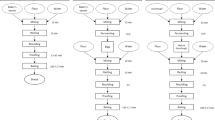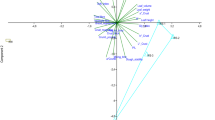Abstract
Common wheat flour is the raw material of choice in bread-making; however, local food customs and the availability of supplies mainly determine the use of ingredients other than common wheat. In Southern Italy, durum wheat semolina from locally grown varieties is mainly used in bread-making that is still performed according to a long-lasting tradition. The traditional traits of some durum breads have been acknowledged by the Italian denomination Prodotto Agroalimentare Tradizionale—standing for Traditional Agricultural Food Product. Among them, “Pane di Monreale” refers to a traditional durum bread produced in the area of Monreale (Sicily). Despite being the cornerstones of the native diet, traditional products have been poorly studied. This paper reports on color characteristics, chemical composition, starch digestibility and carotenoid content of two samples of “Pane di Monreale” bread, made with the durum ancient grains Russello or Tumminia. A dominant red tone was found in the crust of both samples and a low content of lutein was detected. High crude fat and ash content was observed. A low amount of resistant starch was found, while the content of non-starch polysaccharides in Russello bread was two-fold higher than in Tumminia bread.



Similar content being viewed by others
Abbreviations
- PAT:
-
Traditional agricultural food product
- RS:
-
Resistant starch
- AS:
-
Available starch
- TS:
-
Total starch
- FG-MS:
-
Free glucose and maltosaccharides
- NSP:
-
Non-starch polysaccharides
- DF:
-
Dietary fiber
References
Geisslitz S, Wieser H, Scherf KA, Koehler P (2018) Gluten protein composition and aggregation properties as predictors for bread volume of common wheat, spelt, durum wheat, emmer and einkorn. J Cereal Sci 83:204–212. https://doi.org/10.1016/j.jcs.2018.08.012
Lukšič L, Bonafaccia G, Timoracka M et al (2016) Rutin and quercetin transformation during preparation of buckwheat sourdough bread. J Cereal Sci 69:71–76. https://doi.org/10.1016/j.jcs.2016.02.011
Acquistucci R, Melini V, Garaguso I, Nobili F (2018) Effect of bread making process on bioactive molecules in durum wheat bread and assessment of antioxidant properties by Caco-2 cell culture model. J Cereal Sci 83:188–195. https://doi.org/10.1016/j.jcs.2018.08.002
Pasqualone A, De Angelis D, Squeo G et al (2019) The effect of the addition of Apulian black chickpea flour on the nutritional and qualitative properties of durum wheat-based bakery products. Foods 8:504. https://doi.org/10.3390/foods8100504
Melini F, Melini V, Luziatelli F, Ruzzi M (2017) Current and forward-looking approaches to technological and nutritional improvements of gluten-free bread with legume flours: a critical review. Compr Rev Food Sci Food Saf. 16:1101-1122. https://doi.org/10.1111/1541-4337.12279
Melini V, Melini F (2019) Asian grain-based food products and the European scheme for food protected designations of origin: a critical analysis. Trends Food Sci Technol 91:83–94. https://doi.org/10.1016/j.tifs.2019.06.014
Parasecoli F (2017) Knowing where it comes from: labeling traditional foods to compete in a global market. University of Iowa Press, Iowa City, p 52242
Palumbo M, Cambrea M, Licciardello S et al (2013) Collezione di frumento duro in ambiente mediterraneo: germoplasma siciliano e internazionale. In: D’Andrea F (ed) Conservazione biodiversità, gestione banche dati e miglioramento genetico. BIODATI, Roma, pp 497–512
Sciacca F, Allegra M, Licciardello S et al (2018) Potential use of sicilian landraces in biofortification of modern durum wheat varieties: evaluation of caryopsis micronutrient concentrations. Cereal Res Commun 46:124–134. https://doi.org/10.1556/0806.45.2017.056
Dinu M, Whittaker A, Pagliai G et al (2018) Ancient wheat species and human health: biochemical and clinical implications. J Nutr Biochem 52:1–9. https://doi.org/10.1016/j.jnutbio.2017.09.001
Boukid F, Folloni S, Sforza S et al (2018) Current trends in ancient grains-based foodstuffs: insights into nutritional aspects and technological applications. Compr Rev Food Sci Food Saf 17:123–136. https://doi.org/10.1111/1541-4337.12315
Pasqualone A, Alba V, Mangini G et al (2010) Durum wheat cultivar traceability in PDO Altamura bread by analysis of DNA microsatellites. Eur Food Res Technol 230:723–729. https://doi.org/10.1007/s00217-009-1210-1
Bianchi F, Careri M, Chiavaro E et al (2008) Gas chromatographic-mass spectrometric characterisation of the Italian Protected Designation of Origin “Altamura” bread volatile profile. Food Chem 110:787–793. https://doi.org/10.1016/j.foodchem.2008.02.086
Zotta T, Piraino P, Parente E et al (2008) Characterization of lactic acid bacteria isolated from sourdoughs for Cornetto, a traditional bread produced in Basilicata (Southern Italy). World J Microbiol Biotechnol 24:1785–1795. https://doi.org/10.1007/s11274-008-9671-0
International Association for Cereal Science and Technology (2003) ICC Standard Methods. ICC, Vienna
Metodi ufficiali di analisi dei cereali. Determinazione delle sostanze grasse totali. Metodo per idrolisi acida. Gazzetta Ufficiale N.186 del 10-08-1994 Suppl n. 114
AOAC International (2012) Official methods of analysis of AOAC international, 19th edn. Association of Analytical Communities, Gaithersburg
Purlis E (2010) Browning development in bakery products—a review. J Food Eng 99:239–249. https://doi.org/10.1016/j.jfoodeng.2010.03.008
Brescia MA, Sacco D, Sgaramella A et al (2007) Characterisation of different typical Italian breads by means of traditional, spectroscopic and image analyses. Food Chem 104:429–438. https://doi.org/10.1016/j.foodchem.2006.09.043
Ficco DBM, Muccilli S, Padalino L et al (2018) Durum wheat breads ‘high in fibre’ and with reduced in vitro glycaemic response obtained by partial semolina replacement with minor cereals and pulses. J Food Sci Technol 55:4458–4467. https://doi.org/10.1007/s13197-018-3374-9
Singh S, Singh N (2010) Effect of debranning on the physico-chemical, cooking, pasting and textural properties of common and durum wheat varieties. Food Res Int 43:2277–2283. https://doi.org/10.1016/j.foodres.2010.07.016
Acquistucci R, Melini V, Tusa S, Mecozzi M (2019) Effect of different leavening agents on the nutritional characteristics of two durum wheat breads. Eur Food Res Technol 245:2173–2181. https://doi.org/10.1007/s00217-019-03324-x
Rodriguez-Amaya DB (2015) Food carotenoids: chemistry, biology and technology. Wiley Blackwell, Chichester
Colasuonno P, Marcotuli I, Blanco A et al (2019) Carotenoid pigment content in Durum Wheat (Triticum turgidum L. var durum): an overview of quantitative trait loci and candidate genes. Front Plant Sci 10:1347. https://doi.org/10.3389/fpls.2019.01347
Hidalgo A, Brandolini A, Pompei C (2010) Carotenoids evolution during pasta, bread and water biscuit preparation from wheat flours. Food Chem 121:746–751. https://doi.org/10.1016/j.foodchem.2010.01.034
Paznocht L, Kotíková Z, Orsák M et al (2019) Carotenoid changes of colored-grain wheat flours during bun-making. Food Chem 277:725–734. https://doi.org/10.1016/j.foodchem.2018.11.019
Borrelli GM, De Leonardis AM, Platani C, Troccoli A (2008) Distribution along durum wheat kernel of the components involved in semolina colour. J Cereal Sci 48:494–502. https://doi.org/10.1016/j.jcs.2007.11.007
Acquistucci R, Melini V, Carbonaro M, Finotti E (2013) Bioactive molecules and antioxidant activity in durum wheat grains and related millstream fractions. Int J Food Sci Nutr 64:959–967. https://doi.org/10.3109/09637486.2013.825696
Belderok B, Mesdag J, Donner DA (2000) Milling of wheat. Bread-making quality of wheat. Springer, Netherlands, Dordrecht, pp 21–29
Padalino L, Mastromatteo M, Lecce L et al (2015) Effect of raw material on cooking quality and nutritional composition of durum wheat spaghetti. Int J Food Sci Nutr 66:266–274. https://doi.org/10.3109/09637486.2014.1000838
Roman L, Martinez MM (2019) Structural basis of resistant starch (RS) in bread: natural and commercial alternatives. Foods 8:267. https://doi.org/10.3390/foods8070267
Musa-Veloso K, Poon T, Harkness LS et al (2018) The effects of whole-grain compared with refined wheat, rice, and rye on the postprandial blood glucose response: a systematic review and meta-analysis of randomized controlled trials. Am J ClinNutr 108:759–774. https://doi.org/10.1093/ajcn/nqy112
Scazzina F, Del RD, Pellegrini N, Brighenti F (2009) Sourdough bread: starch digestibility and postprandial glycemic response. J Cereal Sci 49:419–421. https://doi.org/10.1016/j.jcs.2008.12.008
Amaral O, Guerreiro CS, Gomes A, Cravo M (2016) Resistant starch production in wheat bread: effect of ingredients, baking conditions and storage. Eur Food Res Technol 242:1747–1753. https://doi.org/10.1007/s00217-016-2674-4
Štěrbová L, Bradová J, Sedláček T et al (2016) Influence of technological processing of wheat grain on starch digestibility and resistant starch content. Starch Stärke 68:593–602. https://doi.org/10.1002/star.201500162
Dhital S, Warren FJ, Butterworth PJ et al (2017) Mechanisms of starch digestion by α-amylase—structural basis for kinetic properties. Crit Rev Food Sci Nutr 57:875–892. https://doi.org/10.1080/10408398.2014.922043
Martínez MM, Román L, Gómez M (2018) Implications of hydration depletion in the in vitro starch digestibility of white bread crumb and crust. Food Chem 239:295–303. https://doi.org/10.1016/j.foodchem.2017.06.122
Kumar V, Sinha AK, Makkar HPS et al (2012) Dietary roles of non-starch polysachharides in human nutrition: a review. Crit Rev Food Sci Nutr 52:899–935. https://doi.org/10.1080/10408398.2010.512671
Acknowledgements
The authors wish to thank Mr Salvatore Tusa for providing bread samples.
Funding
This work was supported by the Italian Ministry of Agricultural, Food and Forestry Policies, under the TERRAVITA project.
Author information
Authors and Affiliations
Corresponding author
Ethics declarations
Conflict of interest
The authors declare they have no conflict of interest.
Compliance with ethics requirements
This article does not contain any experiments with human or animal subjects.
Additional information
Publisher's Note
Springer Nature remains neutral with regard to jurisdictional claims in published maps and institutional affiliations.
Rights and permissions
About this article
Cite this article
Melini, V., Melini, F. & Acquistucci, R. Nutritional characterization of an Italian traditional bread from ancient grains: the case study of the durum wheat bread “Pane di Monreale”. Eur Food Res Technol 247, 193–200 (2021). https://doi.org/10.1007/s00217-020-03617-6
Received:
Revised:
Accepted:
Published:
Issue Date:
DOI: https://doi.org/10.1007/s00217-020-03617-6




